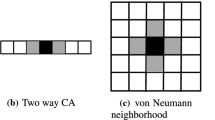Abstract
This paper introduces the problematics deriving from the adoption of asynchronous update schemes in CA models. Several cellular automata update schemes and a tentative classification of such schemes are introduced and discussed. In order to analyze the effects of the different update schemes, a class of simple CA—called One neighbor binary cellular automata (1nCA)—is then introduced. An overview of the general features of 1nCA is described, then the effects of six different updates schemes on all the class of 1nCA are described.











Similar content being viewed by others
References
Bandini S, Manzoni S, Vizzari G (2005) Situated agents interaction: coordinated change of state for adjacent agents. In: Malyshkin VE (ed) PaCT, Lecture notes in computer science, vol 3606. Springer, Berlin, pp 114–128
Bandini S, Vizzari G (2006) Regulation function of the environment in agent-based simulation. In: Weyns D, Parunak HVD, Michel F (eds) E4MAS, Lecture notes in computer science, vol 4389. Springer, Berlin, pp 157–169
Binder P (1993) A phase diagram for elementary cellular automata. Complex Syst 7:241–247
Binder P (1994) Parametric ordering of complex systems. Phys Rev E 49(3):2023–2025
Cornforth D, Green DG, Newth D (2005) Ordered asynchronous processes in multi-agent systems. Physica D 204(1–2):70–82
Darabos C, Giacobini M, Tomassini M (2007) Semi-synchronous activation in scale-free boolean networks. In: e Costa FA, Rocha LM, Costa E, Harvey I, Coutinho A (eds) ECAL, Lecture notes in computer science, vol 4648. Springer, Berlin, pp 976–985
Fang L, Antsaklis P, Tzimas A (2005) Asynchronous consensus protocols: preliminary results, simulations and open questions. In: Decision and control, 2005 and 2005 European control conference. CDC-ECC ’05. 44th IEEE Conference, pp 2194–2199
Fatès N (2003) Experimental study of elementary cellular automata dynamics using the density parameter. In: Morvan M, Rémila (eds) Discrete models for complex systems, DMCS’03, DMTCS proceedings. Discrete mathematics and theoretical computer science, vol AB, pp 155–166
Fatès N, Morvan M (2005) An experimental study of robustness to asynchronism for elementary cellular automata. Complex Syst 16(1):1–27
Gutowitz H, Victor JD, Knight BW (1987) Local structure theory for cellular automata. Physica D 28:18–48
Kanada Y (1994) The effects of randomness in asynchronous 1d cellular automata (poster). Artificial Life IV
Langton CG (1990) Computation at the edge of chaos. Physica D 42:12–37
Li W, Packard N (1990) The structure of the elementary cellular automata rule space. Complex Syst 4(3):281–297
Li W, Packard N, Langton CG (1990) Transition phenomena in CA rule space. Physica D 45:77
Mitchell M, Hraber PT, Crutchfield JP (1993) Revisiting the edge of chaos: evolving cellular automata to perform computations. Complex Syst 7:89–130
Page SE (1997) On incentives and updating in agent based models. Comput Econ 10:67–87
Paolo EAD (2000) Searching for rhythms in asynchronous random boolean networks. In: Bedau M (ed) Alife VII: proceedings of the seventh international conference, MIT Press, Cambridge, pp 73–80
Schönfisch B, de Roos A (1999) Synchronous and asynchronous updating in cellular automata. Biosystems 51(3):123–143
Sutner K (1990) Classifying circular CA. Physica D 45:386
Vichniac GY (1990) Boolean derivatives on cellular automata. Phys D 45(1–3):63–74
Wolfram S (1983) Cellular automata. Los Alamos Sci 9:2–21
Wolfram S (1983) Statistical mechanics of cellular automata. Rev Mod Phys 55:601–644
Wuensche A (1999) Classifying cellular automata automatically: finding gliders, filtering, and relating space-time patterns, attractor basins, and the Z parameter. Complexity 4(3):47–66
Acknowledgment
The work presented in this paper has been partially funded by the University of Milano-Bicocca within the project “Fondo d’Ateneo per la Ricerca - anno 2010”.
Author information
Authors and Affiliations
Corresponding author
Additional information
The work presented in this paper has been partially funded by the University of Milano-Bicocca within the project “Fondo d’Ateneo per la Ricerca - anno 2010”.
Rights and permissions
About this article
Cite this article
Bandini, S., Bonomi, A. & Vizzari, G. An analysis of different types and effects of asynchronicity in cellular automata update schemes. Nat Comput 11, 277–287 (2012). https://doi.org/10.1007/s11047-012-9310-4
Published:
Issue Date:
DOI: https://doi.org/10.1007/s11047-012-9310-4




